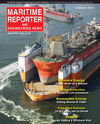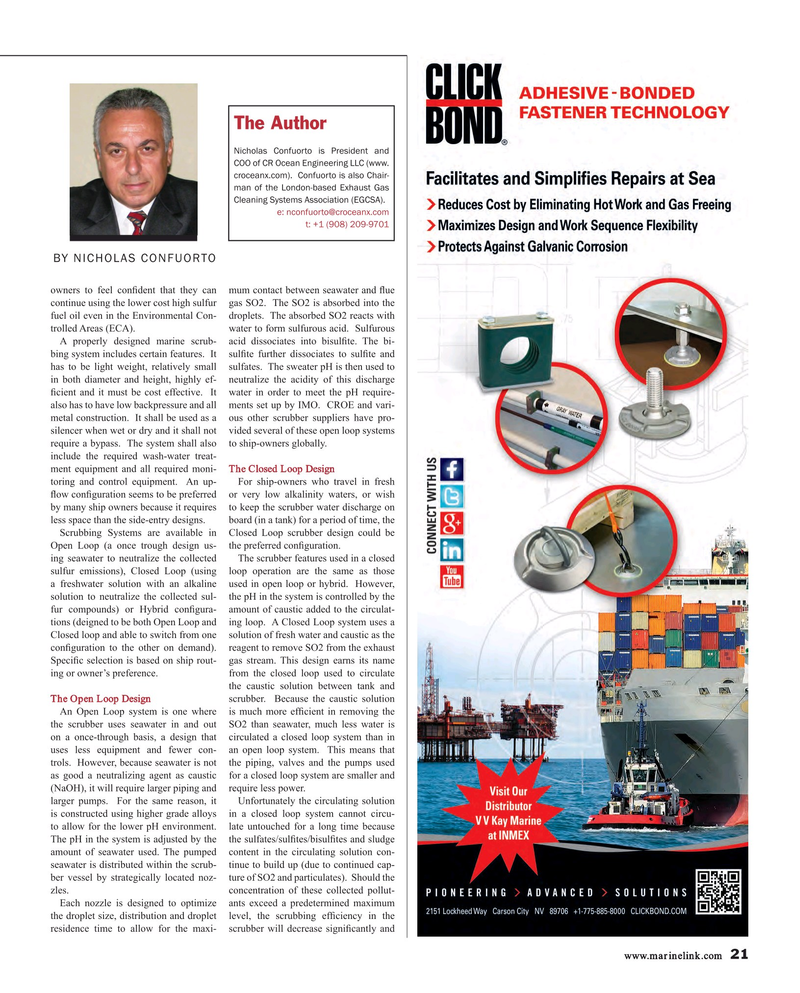
Page 21: of Maritime Reporter Magazine (September 2015)
Offshore Energy Technologies
Read this page in Pdf, Flash or Html5 edition of September 2015 Maritime Reporter Magazine
The Author
Nicholas Confuorto is President and
COO of CR Ocean Engineering LLC (www.
croceanx.com). Confuorto is also Chair- man of the London-based Exhaust Gas
Cleaning Systems Association (EGCSA). e: [email protected] t: +1 (908) 209-9701
BY NICHOLAS CONFUORTO owners to feel con? dent that they can mum contact between seawater and ? ue continue using the lower cost high sulfur gas SO2. The SO2 is absorbed into the fuel oil even in the Environmental Con- droplets. The absorbed SO2 reacts with trolled Areas (ECA). water to form sulfurous acid. Sulfurous
A properly designed marine scrub- acid dissociates into bisul? te. The bi- bing system includes certain features. It sul? te further dissociates to sul? te and has to be light weight, relatively small sulfates. The sweater pH is then used to in both diameter and height, highly ef- neutralize the acidity of this discharge ? cient and it must be cost effective. It water in order to meet the pH require- also has to have low backpressure and all ments set up by IMO. CROE and vari- metal construction. It shall be used as a ous other scrubber suppliers have pro- silencer when wet or dry and it shall not vided several of these open loop systems require a bypass. The system shall also to ship-owners globally. include the required wash-water treat- ment equipment and all required moni- The Closed Loop Design toring and control equipment. An up- For ship-owners who travel in fresh ? ow con? guration seems to be preferred or very low alkalinity waters, or wish by many ship owners because it requires to keep the scrubber water discharge on less space than the side-entry designs. board (in a tank) for a period of time, the
Scrubbing Systems are available in Closed Loop scrubber design could be
Open Loop (a once trough design us- the preferred con? guration. ing seawater to neutralize the collected The scrubber features used in a closed sulfur emissions), Closed Loop (using loop operation are the same as those a freshwater solution with an alkaline used in open loop or hybrid. However, solution to neutralize the collected sul- the pH in the system is controlled by the fur compounds) or Hybrid con? gura- amount of caustic added to the circulat- tions (deigned to be both Open Loop and ing loop. A Closed Loop system uses a
Closed loop and able to switch from one solution of fresh water and caustic as the con? guration to the other on demand). reagent to remove SO2 from the exhaust
Speci? c selection is based on ship rout- gas stream. This design earns its name ing or owner’s preference. from the closed loop used to circulate the caustic solution between tank and
The Open Loop Design scrubber. Because the caustic solution
An Open Loop system is one where is much more ef? cient in removing the the scrubber uses seawater in and out SO2 than seawater, much less water is on a once-through basis, a design that circulated a closed loop system than in uses less equipment and fewer con- an open loop system. This means that trols. However, because seawater is not the piping, valves and the pumps used as good a neutralizing agent as caustic for a closed loop system are smaller and (NaOH), it will require larger piping and require less power. larger pumps. For the same reason, it Unfortunately the circulating solution is constructed using higher grade alloys in a closed loop system cannot circu- to allow for the lower pH environment. late untouched for a long time because
The pH in the system is adjusted by the the sulfates/sul? tes/bisul? tes and sludge amount of seawater used. The pumped content in the circulating solution con- seawater is distributed within the scrub- tinue to build up (due to continued cap- ber vessel by strategically located noz- ture of SO2 and particulates). Should the zles. concentration of these collected pollut-
Each nozzle is designed to optimize ants exceed a predetermined maximum the droplet size, distribution and droplet level, the scrubbing ef? ciency in the residence time to allow for the maxi- scrubber will decrease signi? cantly and www.marinelink.com 21
MR #9 (18-25).indd 21 MR #9 (18-25).indd 21 9/3/2015 10:40:57 AM9/3/2015 10:40:57 AM

 20
20

 22
22
